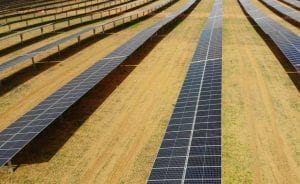Australian renewable energy developers Energy Estate and MirusWind are proposing to build a 4,000MW (4GW) wind, solar and storage facility in New South Wales that will be the biggest single renewable energy project in Australia’s main grid.
The Walcha Energy Project is sited near the town of the same name, about 55km south of Armidale in the New England tablelands, adding to the extraordinary number and scale of wind and solar projects in the heart of ex National Party leader Barnaby Joyce’s electorate.
Energy Estate founder Simon Currie – a former head of energy at legal firm Norton Rose Fullbright – says the region has excellent wind and solar resources, and is close to the backbone of the transmission system and the coal plants in the Hunter Valley that are scheduled to be closed from 2022.
The plan is to combine the wind and solar, and add in storage such as pumped hydro and batteries, and create a new substation and “renewable energy hub” near the town of Uralla.
The proponents say this will ease congestion in the grid, and fits in with plans outlined by Transgrid, the NSW government and the Australian Energy Market Operator, to create the infrastructure to support a major renewable energy zone – one of many planned across the main grid as the country shifts to renewables.
“This multi-technology opportunity will supply low-cost, firmed, renewable energy to NSW customers,” the companies said in a statement. “The recent dramatic falls in the cost of new wind and solar generation means this is now the right time to move ahead with a project of this size and impact in NSW.”
The Walcha Energy Project is by the far the biggest single renewable energy project proposed for the National Electricity Market, and beaten only in scale by the 11GW wind and solar project proposed by CWP, Macquarie, Vestas and others in W.A.s remote Pilbara region, where the output is designed for export to Asia and to support local manufacturing and other industry.
The first stage of the project could be up to 1GW of wind and 400MW of solar, and is expected to begin construction in 2020, delivering its first output by 2022 – when the Liddell coal generator is scheduled for closure. Most of the early development will be wind, with solar also increasing over time along with storage.
“The Walcha Energy Project is a leading example of how integrated renewable energy generation and storage zones are the next stage of Australia’s clean energy transition,” said Simon Corbell, the former ACT climate and energy minister who is chief advisor to Energy Estate.
“Unlocking the clean energy potential of areas like Walcha means delivering clean and dispatchable electricity generation when needed, and enabling new economic development opportunities in regional NSW.”
Corbell told RenewEconomy that the project developers are taking the view that with the exit of fossil fuel generation, integrated zones with multiple resources that can dispatch into multiple markets is a very important opportunity.
“We think it aligns well with the NSW government and AEMO strategic objectives,” Corbell said, noting that the resource had been under proposed development for a significant period of time.
The scale of the project means that, if fully developed, it will more than make up for the Liddell coal-fired generator that is due to close in 2022. Liddell was originally rated at 2GW, was downgraded to around 1.6GW because of its age, and rarely operates at more than half that capacity – and its units often trip because of faults.
The proponents also say they have a “high level “of local community participation from the outset. “The development team has worked closely with Walcha and the surrounding community and has designed innovative arrangements that seek to balance the interests of the landholders, the community and the other stakeholders,” they say.
In fact, community consultations have been ongoing since 2004, when MirusWind first started to work on opportunities in the region. The developers say the landowners have been locked in and have a stake in one of the development companies, and the support of others in the community.
“The time is now right,” sais Currie. “This is not about the renewable energy target any more, this is the next wave of low-cost renewables, and it is close to load centres. This will stand on its own two feet on economics alone.”
The hub solution has been designed by Aurecon, the leading engineering consultancy and grid specialists. It could support the development of a new transmission line from the Hunter Valley to the New England REZ and facilitate a second double circuit interconnector between NSW and Queensland.







